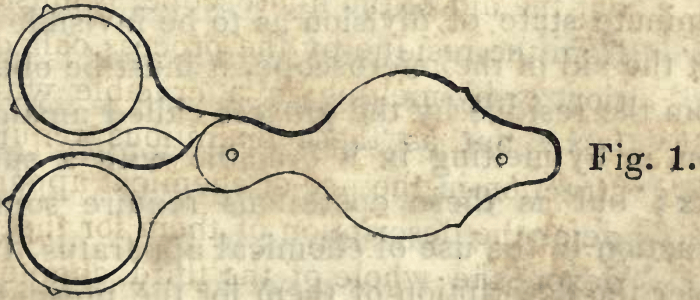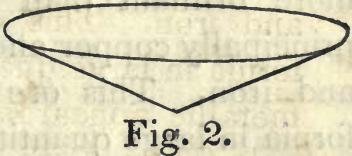Having lately analyzed three specimens of ore from California, all of which were supposed by the possessors to contain gold, and finding but one of them that proved to contain it, I am convinced that the native gold is found in the same localities as some worthless ores, having a yellow colour, and which are often collected or bought under the impression that the latter are valuable.
The object of this work is, therefore, to give such plain and simple instructions for distinguishing the real gold from the spurious, that the most humble individual may be able to protect himself from the imposition of knaves, and prevent a waste of time and labour, in saving only such minerals as are really valuable. I shall, therefore, confine myself to such directions as will be suitable for persons who are supposed to be entirely unacquainted with chemistry.
The native gold found in California occurs in small, regular, flattened grains or spangles, which show by their ovoid shape and smooth edges, that this is their original form, and that they are not broken off from a greater mass. It is found mixed with the sands of the plains and rivers, and when washed from dirt is of a dull orange colour, and on analysis proves to consist almost entirely of pure gold, with a small quantity of silver. It is found most plentifully at low water, and after storms or temporary floods.
In the present state of affairs in California, the operator should be furnished with a few wooden bowls, holding from one to two gallons. A portion of the earth containing the metallic spangles is to be put into one of the bowls, filling it from one quarter to one third full. It is then to be mixed up with water, by stirring with a stick, and while the earthy matter is still suspended in the liquid, it is to be poured off, the gold, from its greater weight, having previously settled to the bottom. This process of washing is to be continued repeatedly, upon the same portion, until the water flows off clear, and the gold is left in shining spangles at the bottom. This is to be taken out and carefully preserved in a well-corked vial, and then a now portion of earth treated as before.
Gold very often exists in such small grains that it is almost invisible when mixed with the earthy matters, and doubtless large quantities are now overlooked and lost, from inability to obtain it by washing only. These fine particles may be obtained as follows : The earth is mixed up with water as before, but is allowed to settle a little longer before decanting off the water, for fear of losing the small particles. The time allowed for settling, before pouring off the water at each washing, must be regulated according to the relative density of the earthy matters, and of the gold to be separated ; for instance, after mixing the earth well with the water, it may be left to settle for a half minute, then poured off; mixed again with water, settled for half a minute, and again poured off, and so on repeatedly till the residue is clean, although it may still contain grams of sand. If, on examination of the residue with a small pocket microscope, (Fig. 1,)

it is found to consist principally of gold, this shows that the earthy matters and sand having been washed away so cleanly, that some metallic particles may have been washed away with them. In order to prove this, some of the last washings of the next operation should be saved in a bowl, allowed to settle, and then examined with the microscope. If these washings contain gold, a longer time, say three quarters of a minute, to a minute or more, must be allowed for settling at each washing, so as to allow the gold to subside before the water is poured off. It is impossible to give the exact time that the mixture should be allowed to settle before it is poured off, as this depends entirely upon circumstances. This, however, can with a little care be so arranged that no gold will be lost, because this metal is heavier than all other bodies except platina, and will consequently settle first when mixed with lighter bodies.
When the gold is plentiful, and found in such large grains as to be visible to the naked eye, and the small particles are not present, this extreme care in washing may be dispensed with, because the large grains require no further treatment after being washed clean ; but where the gold is in such a minute state of division as to be invisible without the aid of the microscope, it must be obtained from the residue by the process called amalgamation, or by melting in a crucible with a suitable flux ; but as these operations require some instruction in the use of chemical apparatus, I shall defer the description of them for the present, and devote the whole of the third chapter to that important subject.
The most simple, and probably the best method of washing gold to separate it from earthy matters is practised in some parts of Europe, as follows: The washing is performed in a wooden bowl or dish, formed like a very flat cone, (Fig. 2,) and which is from 15 to 18 inches in diameter, and 3 or 4 inches deep. It requires some skill in order to perform this operation to advantage. The dish filled with about 20 pounds of the earth or sand containing gold, is carried into a river, if possible, where the operator stands above his knees in water, protected with india rubber boots, which come up to the thighs. The dish is plunged into the stream, and the mixture stirred up with the hand; the dish is dexterously whirled in such a manner, that at each gyration it is inclined at different angles, so as to allow the matters suspended in the water to flow out, while the gold remains at the bottom, in the angle of the cone. The washing is to be repeated till the gold is left clean; it is then transferred into a small iron dish and dried.

If the above shaped bowls cannot be obtained, those sold at the wooden ware stores must be purchased. But those with conical bottoms are much better, as they retain the gold in a small space. Vessels of wood are preferred to metal, as the slight, roughness of the interior prevents the little particles of gold from siding out, and being buoyant, they can be left at rest on the surface of the water, when necessary, without danger of sinking.
Two of the spurious samples which I have analyzed, somewhat resemble gold in external appearance. They are in small bright pieces, not uniform in shape, and of a light yellow colour, more brilliant than pure gold, but containing principally copper and arsenic, with traces of zinc and iron. This ore seems to be found in California in large quantities, and from the fact of its metallic appearance and yellow colour, it is difficult for one unacquainted with such matters to distinguish it from pure gold, without resorting to chemical tests.
Another sample required but a slight examination to prove that it was iron pyrites. A part of it is in pieces of irregular size and shape, and some is in well formed cubical crystals. It is very brittle, breaking easily under the hammer, and strikes fire with steel. On the outside of the mineral the colour is dark brown, Inside it is bronze yellow. These characters are sufficient to identify this ore without a chemical examination.
One of the samples containing copper, and also the iron pyrites, were handed to me for examination by the editor of one of our city papers, who informed me that he received them from a person who bought them in the vicinity of the California mines.
The other sample, containing copper, was handed to me by a person who said that he received it from one of the soldiers of Col. Stevenson’s regiment
The sample of real gold which I analyzed and found pure, was presented to me by one of the firm of a large commission house in this city, who assured me that they received it direct from a brother of one of the firm who resides in San Francisco; this sample being from a lot containing about $9,000 worth of gold.
Not having been in California personally, I am obliged to give the statements of other individuals (without, however, doubting their truth) as to the sources from which all of the above specimens were obtained. But the analyses of all the samples I performed myself. Specimens of those which I have tested may be seen at No. 116 John- street, N. Y.
